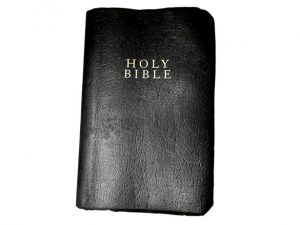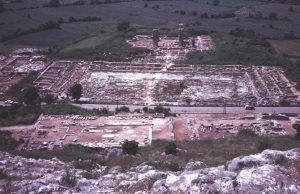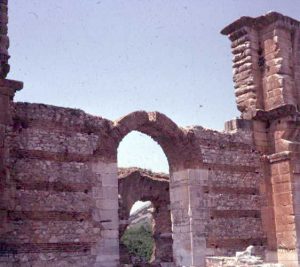In recent years, scholars of the New (Christian) Testament of the Bible – comprised of documents composed between 50 and 150 of the Common Era (CE) – have begun using the tools and interpretations of archaeologists in our quest for the context in which the earliest Christians lived. Since the apostle Paul (a Jew, let us recall) wrote letters to communities at Rome, Corinth, Thessaloniki, and Philippi and traveled extensively throughout the Roman Empire, scholars like myself have been studying material remains – buildings, mosaics, paintings, pottery, coins, papyri, inscriptions, skeletal remains and so on – in addition to Biblical texts and other early Christian and Jewish literature. (Note that my primary area of expertise is early Christianity; studies of Judaism in the early Roman Empire parallel this work, and I will comment on Jewish aspects when I am able.) In this post, we will look at some of the findings of this scholarly pursuit and examine why the information we have found matters to modern folk, religious and secular alike. 
The Field and Findings
While archaeological excavations of the ancient world have been undertaken since at least the late 18th century, scholars of the Christian Testament and the early church have only been studying archaeological findings for two generations. New Testament (NT) scholarship has focused primarily on texts, written in a number of ancient languages. Most traditionally-trained NT scholars are thus uncomfortable with archaeological evidence and tend to stay away from it. (With regard to Near Eastern and Judaism studies, archaeological work has been conducted for more than a century in the Middle East, but those scholars seem to be more in tune with archaeological evidence than NT scholars have been.)
It is a mistake, therefore, for NT scholars to focus so heavily on literature to the exclusion of archaeology. There is overlap between Judaism, Christianity, and paganism in many excavations in the Mediterranean arena, since sites often have habitation layers over millennia, so much important information can be found by studying “dig” reports and related sources.  Those of us who embarked on this way of studying the world of early Christianity have not only consulted dig reports and other sources about archaeological sites where Paul and other early Christians lived and worked but have even visited them in person and consulted with the resident archaeologists. We have stood in streets and marketplaces where those ancients had stood, we’ve seen (and sometimes even handled) everyday and religious objects crafted and used by imperial-era people, and we’ve unearthed skeletal remains of long-dead ancestors. A number of important conferences, long-term projects and high-quality publications have resulted from this work over the past several decades (additional resources, below).
Those of us who embarked on this way of studying the world of early Christianity have not only consulted dig reports and other sources about archaeological sites where Paul and other early Christians lived and worked but have even visited them in person and consulted with the resident archaeologists. We have stood in streets and marketplaces where those ancients had stood, we’ve seen (and sometimes even handled) everyday and religious objects crafted and used by imperial-era people, and we’ve unearthed skeletal remains of long-dead ancestors. A number of important conferences, long-term projects and high-quality publications have resulted from this work over the past several decades (additional resources, below).
What is exciting to those of us who undertake this work is several fold: we can see more clearly how the “average” person lived in antiquity, we can gain insight about the social context described in the written materials, and we can begin to correct longstanding misinterpretations. In earlier posts, we have illustrated some of these findings:
- Women in the ancient world and the early church
- Female symbols in the Roman catacombs
- The early Christian symbol of the Orante
- When early Christians revered a female deity
- Images of the ancient city of Philippi
What becomes readily apparent when studying material remains is that one is in contact not only with the literate people whose words have been preserved (usually high-status men) but also with women, children, slaves, and lower-status men. Even though we may read a passage in Paul’s first-century letter from a Western, primarily “Christian,” perspective, seeing pagan artifacts both alongside and chronologically later than Paul’s time makes us realize that Christianity was a distinctly minority “sect” for several centuries that emerged from Judaism (which was also not monolithic in this era).  At Philippi, for instance, a pagan altar to the Egyptian goddess Isis, bearing Christian symbols, rests at the city gate and near two inscriptions appealing to Jesus for help in protecting the city. The altar dates from the third century, while the inscriptions are much later (5th or 6th century), showing that residents of Philippi, well into early Byzantine times, were appealing to both a pagan goddess and the Christian deities (including Mary) for help. Since literature about Philippi is nearly non-existent from this time, the archaeological evidence is vital and demonstrates that Christianity was far from uniquely dominant long after Paul’s time.
At Philippi, for instance, a pagan altar to the Egyptian goddess Isis, bearing Christian symbols, rests at the city gate and near two inscriptions appealing to Jesus for help in protecting the city. The altar dates from the third century, while the inscriptions are much later (5th or 6th century), showing that residents of Philippi, well into early Byzantine times, were appealing to both a pagan goddess and the Christian deities (including Mary) for help. Since literature about Philippi is nearly non-existent from this time, the archaeological evidence is vital and demonstrates that Christianity was far from uniquely dominant long after Paul’s time.
Why it Matters
Archaeological evidence from cities of the Roman Empire provides information that makes us question assumptions that has long emerged from the standard literature. How might this inform not only our faith, if we are Christian, but also our view of the modern world, as citizens of it?
Perhaps most importantly is that we must always take a humble approach to both the texts and the physical evidence; all is not what it necessarily seems (especially given the vagaries of translation and transmission of ancient texts). Visiting an excavation site with Jewish or Christian heritage, and/or reading about it from an archaeologist’s point of view, compels us to absorb the words of Paul and others – Gospel writers, church fathers, Jewish leaders, even “heretics” – from an agrarian, pre-industrial standpoint. We must think in terms of empire and poverty, patronage and slavery, exquisite art and heartless slaughter. Our Christian forebears were both superstitious and wise, strong and oppressed, conflicted and assured, artistic and cruel. Some merely added Christ to their religious repertoire late in life, while others forsook all other deities to the point of martyrdom. There were many Jewish groups at this time (such as the Sadducees and Pharisees of the NT), as well as Jewish revolts against oppression, so these theological, sociological and political considerations must always be taken into account. The meshing of both the written word and the physical objects that early Christians, Jews and pagans left behind greatly augment our knowledge for knowledge’s sake but also inform, and sometimes change, the socio-political stances of the West.
Here are a few specific insights that are enhanced for our modern culture by pairing archaeology with more traditional methods of Bible scholarship.
- Christianity did not completely “conquer” paganism and become the “state religion” until well into the Byzantine era, and it only split from Judaism a couple of generations after Jesus. Despite sporadic pagan (imperial) persecution or harassment of both Judaism and Christianity, and later Christian suppression of paganism, there is evidence from throughout the early imperial era (from the catacombs and elsewhere) that most groups co-existed peacefully for centuries in most communities. This evidence belies the traditional notion of Christian superiority and is a strong argument for humility in our religious stances and in social and political policies based upon those stances.
- Jews and early Christians were, in large part, subjects of the Roman Empire – oppressed peoples living at subsistence level, for the most part, and often slaves. This means that we must read the Bible, especially Christian texts, from the standpoint of oppression, poverty and marginalization, often in opposition to colonialist regimes, not as if our forebears were fairly comfortable middle-class Westerners.
- Women were leaders in both Judaism and the early church. Some female leaders are mentioned in the texts, but the archaeological evidence makes it much harder for religious leaders (and political leaders relying on religious notions) to ignore female leadership when it comes to women’s ordination, imposing women’s silence in congregations, and otherwise granting women only second-class citizenship.
- Women could be business owners, artists and artisans in antiquity. This means that we can no longer automatically assume, when evaluating ambiguous evidence from the ancient world, that an object was created by a man or that a building was dedicated to or used by a man or men.
 The possibility that the object was created by a woman, or the business owned or operated by a woman, compels us to allow for various interpretations of that socio-economic context.
The possibility that the object was created by a woman, or the business owned or operated by a woman, compels us to allow for various interpretations of that socio-economic context. - Same-sex relationships among both men and women were accepted in the early church and not condemned. This refutes the argument that such relationships were always forbidden or disparaged in Christianity and should thus not be allowed today.
There is only so much information that can be gleaned about peoples of the early Roman Empire, including our Jewish and Christian ancestors, from texts, most of which were written by upper-status men. Supplementing literary and textual evidence with archaeological evidence is crucial for elucidating and understanding the lives of these ancient peoples, upon whose shoulders we in the West have been standing for millennia.
Resources
Abrahamsen, Valerie. “Burials in Greek Macedonia: Possible Evidence for Same-Sex Committed Relationships in Early Christianity,” Journal of Higher Criticism, Vol. 4, No. 2 (Fall 1997) 33-56.
Abrahamsen, Valerie. “Evidence for a Christian Goddess: The Bendis-Zodiac Relief at Philippi,” Forum, Third Series 1, 1 (Spring 2007; copyright 2010) 97-112.
Abrahamsen, Valerie. “Priestesses and Other Female Cult Leaders at Philippi in the Early Christian Era.” in Joseph A. Marchal, ed., The People beside Paul: The Philippian Assembly and History from Below, 25-62. Atlanta, GA: SBL Press, 2015.
Abrahamsen, Valerie. “Women Artisans in the Service of the Church,” Sisters Today, Vol. 65, No. 2 (March 1993) 96-103.
Abrahamsen, Valerie. “Women at Philippi: The Pagan and Christian Evidence,” Journal of Feminist Studies in Religion, Vol. 3, No. 2 (Fall 1987) 17-30.
Boswell, John. Same-sex Unions in Premodern Europe. New York: Villiard Books, 1994.
Brooten, Bernadette. Women Leaders in the Ancient Synagogue, Brown Judaic Studies no. 36. Chico, CA, 1982.
Oakes, Peter. Philippians: From People to Letter. Cambridge: Cambridge University Press, 2001.
Additional resources
Abrahamsen, Valerie. “Christianity and the Rock Reliefs at Philippi,” Biblical Archaeologist, Vol. 51, No. 1 (March 1988) 46-56.
Abrahamsen, Valerie. “Female Imagery in Christian Apocryphal Art,” Journal of Higher Criticism, Vol. 12, No. 1 (Spring 2006) 1-16.
Abrahamsen, Valerie A. Goddess and God: A Holy Tension in the First Christian Centuries. Marco Polo Monographs 10. Warren Center, PA: Shangri-La Publications, 2006.
Abrahamsen, Valerie A. Women and Worship at Philippi: Diana/Artemis and Other Cults in the Early Christian Era. Portland, ME: Astarte Shell Press, 1995.
Bakirtzis, Charalambos and Helmut Koester, eds. Philippi at the Time of Paul and after His Death. Harrisburg, PA: Trinity Press International, 1998.
Crossan, John Dominic and Jonathan L. Reed. Excavating Jesus: Beneath the Stones, Behind the Texts. New York: HarperCollins Publishers, Inc., 2001.
Ducrey, Pierre. “The Rock Reliefs of Philippi,” Archaeology 30 (1977) 102-07.
Edwards, Douglas R. and C. Thomas McCollough. Archaeology and the Galilee: Texts and Contexts in the Graeco-Roman and Byzantine Periods. Atlanta: Scholars Press, 1997.
Friesen, Steven J., Daniel N. Schowalter, and James C. Walters, editors. Corinth in Context: Comparative Studies on Religion and Society. Leiden and Boston: Brill, 2010.
Furnish, Victor Paul. “Corinth in Paul’s Time: What can Archaeology Tell us?” Biblical Archaeology Review, May/June 1988, 15-27.
Hendel, Ronald. “The Bible and Religious Violence,” Biblical Archaeology Review (March/April 2016) 22, 66.
Hendrix, Holland L. “Philippi,” Anchor Bible Dictionary, Vol. 5, 313-17. David Noel Freedman, Editor-in-Chief. New York and London: Doubleday, 1992.
Hendrix, Holland L. “Thessalonica,” Anchor Bible Dictionary, Vol. 6, 523-27. David Noel Freedman, Editor-in-Chief. New York and London: Doubleday, 1992.
Hills, Julian V., editor. Common Life in the Early Church: Essays Honoring Graydon F. Snyder. Harrisburg, PA: Trinity Press International, 1998.
Horsley, Richard A. Archaeology, History and Society in Galilee. Valley Forge, PA: Trinity Press International, 1996.
Horsley, Richard A., ed. Christian Origins: A People’s History of Christianity, Vol. 1. Minneapolis: Fortress Press, 2005.
Horsley, Richard A., ed. Paul and Empire: Religion and Power in Roman Imperial Society. Harrisburg, PA: Trinity Press International, 1997.
Kraemer, Ross Shepard and Mary Rose D’Angelo, eds. Women and Christian Origins. New York and Oxford: Oxford University Press, 1999.
Lanci, John R. A New Temple for Corinth: Rhetorical and Archaeological Approaches to Pauline Imagery. New York, etc.: Peter Lang, 1997.
Lemaire, André. “Burial Box of James the Brother of Jesus,” Biblical Archaeology Review, Vol. 28, No. 6 (November/December 2002) 24-33.
Leith, Mary Joan Winn. “Earliest Depictions of the Virgin Mary,” Biblical Archaeology Review, Vol. 43, No. 2 (March/April 2017) 40-49, 68-70.
McCabe, Elizabeth A. An Examination of the Isis Cult with Preliminary Exploration into New Testament Studies. Lanham/Boulder/New York: University Press of America, 2008.
Murphy-O’Connor, Jerome, O.P. St. Paul’s Corinth: Texts and Archaeology. Wilmington, DE: Michael Glazier, Inc., 1983, 1987.
Nasrallah, Laura, Charalambos Bakirtzis and Steven J. Friesen, editors. From Roman to Early Christian Thessaloniké: Studies in Religion and Archaeology. Cambridge, MA: Harvard University Press, 2010.
Portefaix, Lilian. Sisters Rejoice. Uppsala: Coniectanea Biblica; New Testament Series 20, 1988.
Reed, Jonathan L. Archaeology and the Galilean Jesus: A Re-examination of the Evidence. Harrisburg, PA: Trinity Press International, 2000; paperback edition, 2002.
Sabar, Ariel. “Unearthing the World of Jesus,” Smithsonian (January/February 2016) 43-55, 122-30.
Snyder, Graydon F. Ante Pacem: Archaeological Evidence of Church Life Before Constantine, revised edition. Macon, GA: Mercer University Press, 2003.
White, L. Michael. The Social Origins of Christian Architecture, Vol. 1. Valley Forge, PA: Trinity Press International, 1990.
Witt, Rex E. Isis in the Graeco-Roman World. Ithaca: Cornell University Press, 1971.
